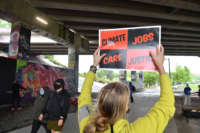
As we work to combat the climate crisis, it’s clear that electricity providers must shift toward using more renewable energy to generate power. Clearly, more regulations are needed. But depending on where you are in the country, the word “regulation” is met with heavy resistance. So, why not try a reframe?
Some clever folks did just that. They came up with the label “Renewable Portfolio Standard,” also called “Renewable Energy Standards,” a policy approach that has spread rapidly with real impact.
The Renewable Portfolio Standard (RPS) is a public mandate, typically initiated by a state legislature with the purpose of increasing energy from renewable sources — wind, solar, and other alternatives to fossil fuel and nuclear power. Another purpose has been to drive renewable innovation by signaling a predictable, growing market. The law sets renewable energy production targets for utilities — either in the amount of energy they produce or as a share of their energy output — along with consequences for not meeting them, usually a fine.
Way back in 1983, Iowa became the first state to try this type of renewable energy mandate. The state’s Renewable Portfolio Standard mandated that Iowa’s two main utility companies own or secure by contract a total of 105 megawatts (MW) of renewables, or enough to power several hundred homes. Not a terribly impressive requirement … but a start. From this baby step came a big leap. By 2019, Iowa was the second largest wind power producer, after Texas. And by 2020, wind energy from more than 5,100 turbines powered 57 percent of Iowa’s net electricity generation — a bigger share than any other state.
As of early 2021 the state was generating around 11,500 megawatts of renewable-based energy, nearly 110 times the energy potential of Iowa’s original 105 megawatt renewables target.
Iowa’s success has played a pivotal role in moving others to use the Renewable Portfolio Standard. Now, 30 states, plus Washington, D.C., and three territories have adopted the policy or a similar approach to mandate a shift in electricity generation.
In 2004, as the most oil-dependent state in the nation, Hawaii changed its renewable portfolio “goal” to an enforceable standard. In a 2015 update to the standard, Hawaii became the first state to set a target of using 100 percent renewable energy by 2045. Gov. David Ige explained: “Hawaii spends roughly $5 billion a year on foreign oil to meet its energy needs. Making the transition to renewable, indigenous resources for power generation will allow us to keep more of that money at home, thereby improving our economy, environment, and energy security.”
In 2018, California took the same step, setting a 100 percent renewable energy production goal by 2045. Understanding the urgency of this act, then-Gov. Jerry Brown declared to the press, “It will not be easy. It will not be immediate. But it must be done.”
The results are impressive: Clearly, lack of federal leadership did not stop significant state action.
If you thought Iowa’s use of renewable portfolio standards was unexpected, consider that even in Texas — where we know ideas like “big government” and “regulations” sound unpopular — lawmakers were willing to pass a renewable energy requirement when it was framed as a “Renewable Portfolio Standard.”
In 2002, after much give-and-take, the Texas legislature enacted Senate Bill 7, amending the state’s utility code and allowing for competition in the state’s retail electricity market. The Lone Star State put in place a Renewable Portfolio Standard. It required that by 2009 electricity providers collectively supply consumers with 2,000 megawatts of renewable power, enough to power about a third of a million homes.
When it became clear that this goal would be met three years early in Texas, the state legislature more than doubled the requirement to just over 5,000 megawatts by 2015. As before, wind development blew past forecasts. This achievement was possible because Texas had approved construction of transmission lines to route electricity from remote wind farms to large urban markets. As of May 2021, the state’s installed wind capacity had reached nearly 40,000 megawatts — more than six times the goal mandated just four years earlier. Now leading the nation in wind energy, Texas currently generates 20 percent of U.S. wind-powered electricity.
Meanwhile, in less than a decade, Virginia has become a renewable energy powerhouse. It’s on track to produce more than half of its electricity from renewables by 2035, and all of it a decade later.
In March, the 2020 Virginia Clean Economy Act went into effect. It’s got real teeth: mandated benchmarks over 15 years for solar and wind investment and a Renewable Portfolio Standard requiring the state’s utilities to provide fully renewable electricity by 2045.
If the entire U.S. were to adopt similar policies to these state-wide initiatives and enact a national goal of a 50 percent renewable energy standard by 2035, potentially we could cut CO2 emissions in the nation’s power sector by over 45 percent and reduce national natural gas generation by 38 percent over the next 15 years. These reductions—although falling slightly short of national efforts by President Biden to halve our current CO2 emissions within the next decade — would put us on track to achieve net-zero emissions by 2050.
Almost half the growth of U.S. renewable energy from 2000 to 2019 can be linked to state Renewable Portfolio Standards — with more expected over the next decade. But that’s about the only blanket statement one can make about them. This reminds us of Justice Brandeis’s observation nearly 90 years ago, perhaps no more important today: “It is one of the happy incidents of the federal system that a single courageous state may, if its citizens choose, serve as a laboratory; and try novel social and economic experiments …”
States have implemented differing approaches. Standards range from Washington, D.C.’s call for 100 percent renewable energy by 2032 to Iowa’s modest, but long-surpassed, 1983 renewables goal. Many states mandate that renewables comprise a minimum share of retail electric sales — generally between 10 and 45 percent, though 14 states require 50 percent or greater. Rather than mandating that a particular share of energy be renewable, two national leaders, Iowa and Texas, require specific amounts of renewable energy capacity.
In creating investment certainty, states’ “standards” mandates have been astonishingly successful in driving the growth of renewable energy and advancing renewable energy technology, all the while driving down our reliance and generation of fossil fuel source production, which has been steadily declining in the past several years. In fact, the U.S. now generates more than double the total renewable energy that was called for in the 29 states’ standards put together.
While this statistic is extremely impressive, we must also note that individual states can’t fight this national effort alone. These regional efforts constitute only a fraction, albeit a powerful one, of the necessary measures our nation must take in order to foster renewable energy systems that aren’t reliant on detrimental fossil fuels.
Let us all support the efforts of organizations and leaders rewriting our nation’s energy story. The youth-led Sunrise Movement as well as 350.org are leading the charge for renewable energy, fossil fuel emitter accountability, and just, equitable and sustainable energy grids — all the while upgrading the most crucial element of American infrastructure, democracy itself. They, among others, deserve praise and support for advancing the Green New Deal and President Biden’s Plan for a Clean Energy Revolution and Environmental Justice. Renewable Portfolio Standards are just one tool in what must become a broad, transformative strategy for how we power our society — a strategy that, I’m thrilled to say, is already significantly underway.
Note: If you want to discover where your state stands on renewable energy mandates, here is a handy interactive site from the U.S. Energy Information Administration. The author would like to thank Nina Larbi, Olivia Smith and Rachel Madison for their assistance on earlier drafts.
This post was originally published on Latest – Truthout.













